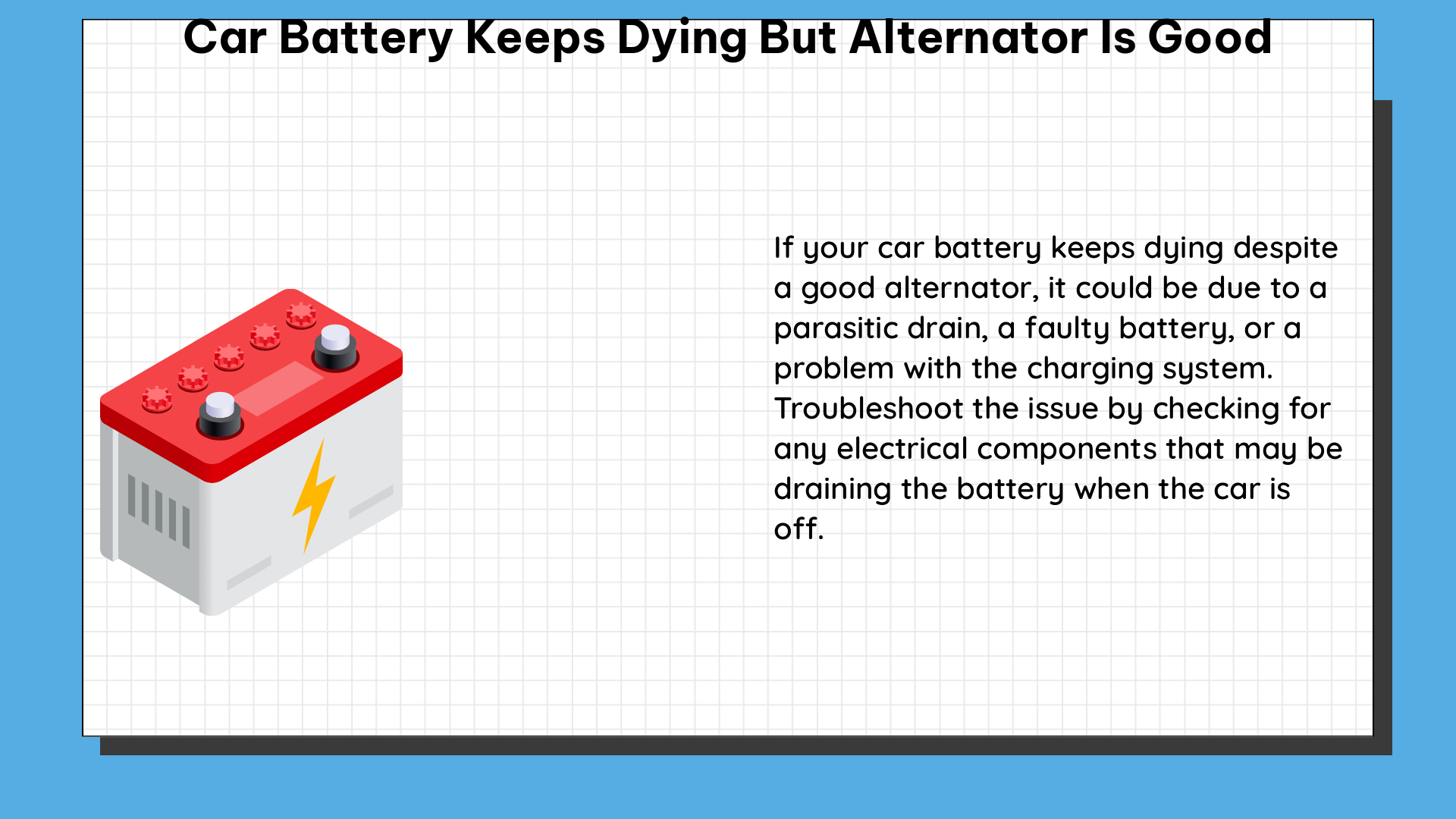When your car’s battery keeps dying, even though the alternator is functioning correctly, it can be a frustrating and perplexing issue. However, with the right diagnostic approach and a deep understanding of the underlying causes, you can effectively resolve this problem and get your vehicle back on the road. In this comprehensive guide, we’ll delve into the various factors that can contribute to a dying battery despite a good alternator, providing you with the technical knowledge and practical steps to identify and address the root cause.
Loose Wires and Connections
One of the most common reasons for a car battery to keep dying, even with a functioning alternator, is loose wires and connections. Over time, the battery cables and terminals can become corroded or loosened, leading to a poor electrical connection between the battery and the rest of the vehicle’s electrical system. This can prevent the battery from being properly charged, causing it to drain prematurely.
To check for loose wires and connections, follow these steps:
- Visually inspect the battery terminals and cables for any signs of corrosion or damage. Clean the terminals with a wire brush or baking soda and water solution, and ensure that the connections are tight.
- Use a multimeter to measure the voltage drop across the battery cables. The voltage drop should be less than 0.2 volts, indicating a good connection. If the voltage drop is higher, the cables or connections may need to be replaced.
- Check the ground connection, which is typically located on the engine block or chassis. Ensure that the ground connection is clean, tight, and free of any corrosion.
Parasitic Drain

Another common cause of a dying battery, even with a functioning alternator, is parasitic drain. Parasitic drain occurs when there is a constant draw of power from the battery, even when the car is turned off. This can be caused by a variety of issues, such as a faulty electrical component, a wiring problem, or a malfunctioning control module.
To check for parasitic drain, follow these steps:
- Disconnect the negative battery cable and connect a multimeter in series with the battery. The multimeter should be set to measure current (amperes).
- With the car turned off and all accessories disabled, note the current reading on the multimeter. A reading of more than 50 milliamps (0.05 amps) indicates a parasitic drain.
- To isolate the source of the parasitic drain, start disconnecting fuses one by one until the current reading drops to an acceptable level. This will help you identify the circuit or component causing the drain.
Faulty Voltage Regulator
The voltage regulator is a critical component in the vehicle’s electrical system, responsible for maintaining the correct voltage level. If the voltage regulator is malfunctioning, it can cause the battery to be undercharged or overcharged, leading to premature battery failure.
To check the voltage regulator, follow these steps:
- Start the engine and let it idle.
- Use a multimeter to measure the voltage at the battery terminals. The voltage should be between 13.8 and 14.4 volts, indicating a properly functioning voltage regulator.
- If the voltage is outside of this range, the voltage regulator may need to be replaced.
Ground Connection and Starter Issues
Issues with the ground connection or the starter can also contribute to a dying battery, even with a good alternator. A bad ground connection can prevent the battery from being properly charged, while a problem with the starter can cause excessive current draw, draining the battery.
To check the ground connection and starter, follow these steps:
- Inspect the ground connection for any signs of corrosion or damage. Clean the connection and ensure that it is tight.
- Use a multimeter to measure the voltage drop across the ground connection. The voltage drop should be less than 0.2 volts.
- Check the starter by performing a load test. This will help identify any issues with the starter that may be causing excessive current draw.
Technical Specifications
- Battery voltage: A fully charged 12-volt battery should have a voltage level of around 12.6 volts.
- Parasitic drain: A multimeter reading of more than 50 milliamps (0.05 amps) indicates a parasitic drain.
- Voltage regulator: The voltage regulator is responsible for maintaining the correct voltage level in the electrical system, typically around 14.4 volts when idling.
Conclusion
By understanding the various factors that can contribute to a car battery keeping dying, even with a good alternator, you can effectively diagnose and resolve the issue. Remember to thoroughly inspect the wiring, check for parasitic drain, test the voltage regulator, and examine the ground connection and starter. With the right troubleshooting approach and the technical knowledge provided in this guide, you’ll be well on your way to getting your vehicle’s electrical system back in top shape.
References:
- Community Car Talk: Battery, Alternator Good, Car Keeps Dying
- Mechanics Stack Exchange: Battery Tested Good, But It Keeps Getting Drained
- Reddit r/MechanicAdvice: Car Keeps Going Dead, But Battery and Alternator Are Good

The lambdageeks.com Core SME Team is a group of experienced subject matter experts from diverse scientific and technical fields including Physics, Chemistry, Technology,Electronics & Electrical Engineering, Automotive, Mechanical Engineering. Our team collaborates to create high-quality, well-researched articles on a wide range of science and technology topics for the lambdageeks.com website.
All Our Senior SME are having more than 7 Years of experience in the respective fields . They are either Working Industry Professionals or assocaited With different Universities. Refer Our Authors Page to get to know About our Core SMEs.